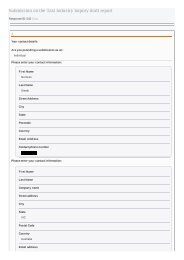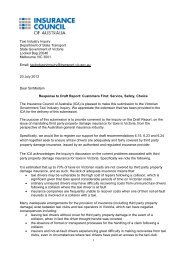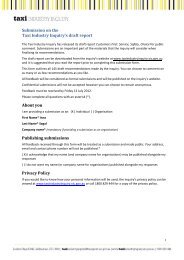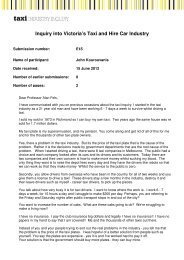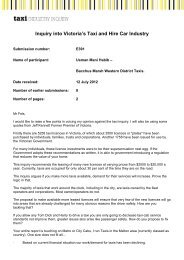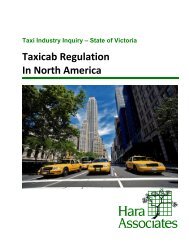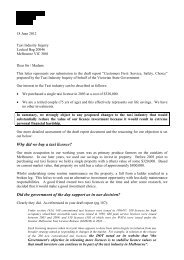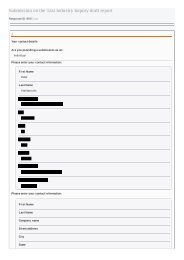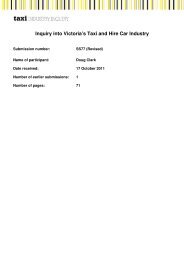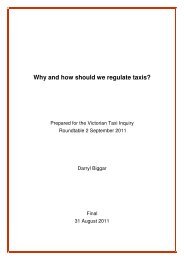Part D â Understanding and improving industry performance (PDF ...
Part D â Understanding and improving industry performance (PDF ...
Part D â Understanding and improving industry performance (PDF ...
Create successful ePaper yourself
Turn your PDF publications into a flip-book with our unique Google optimized e-Paper software.
More recently in the United States, a number of cities<br />
have moved to open market arrangements while<br />
maintaining fare <strong>and</strong> quality controls (such as Indianapolis<br />
<strong>and</strong> Minneapolis). Phoenix <strong>and</strong> Washington DC also<br />
maintain open markets.<br />
9.3.2. Fare controls<br />
The experiences of other jurisdictions suggest that<br />
the relaxation of licence controls does not necessarily<br />
result in the full realisation of anticipated competitive<br />
<strong>and</strong> efficient markets. Fares do not invariably<br />
decrease if fare controls are relaxed or removed.<br />
These experiences have highlighted the need for<br />
jurisdictions to be aware of the interaction between<br />
fares <strong>and</strong> entry controls at the time of deregulation.<br />
For example, the Netherl<strong>and</strong>s deregulated its taxi <strong>industry</strong><br />
during the period 2000 to 2002. During this time, a new<br />
national maximum fare was introduced temporarily, with<br />
the intention of protecting consumers from any initial<br />
excessive price rises as a result of licence liberalisation.<br />
The Government’s expectation was that competition would<br />
increase <strong>and</strong> the maximum fare could then be removed.<br />
However, the outcome was an increase in fares – the<br />
national maximum fare was actually set relatively higher<br />
than the average fare under the previous regime <strong>and</strong> this<br />
allowed operators the freedom to charge higher fares. 8 The<br />
effect was that, while the availability of services improved<br />
with an increase in taxi numbers, fares under this scheme<br />
also increased to close to the maximum fare.<br />
On the other h<strong>and</strong>, New Zeal<strong>and</strong> allowed <strong>industry</strong><br />
participants to set their own fares when it deregulated<br />
entry <strong>and</strong> fares (see case study). However, maximum<br />
fares for each taxi organisation have to be registered with<br />
<strong>and</strong> approved by the NZTA before coming into effect.<br />
Fares are calibrated on the meter <strong>and</strong> information on<br />
fares displayed inside <strong>and</strong> outside the taxi. Early studies<br />
suggested that the effects were generally positive. These<br />
studies found that in New Zeal<strong>and</strong>’s large cities, entry<br />
increased but real fares decreased. 9 The inquiry’s view<br />
is that, broadly, the relaxation of fare controls in New<br />
Zeal<strong>and</strong> has allowed innovation <strong>and</strong> price differentiation<br />
to a degree. While a common approach to structuring<br />
fares is required, ATOs can emphasise different elements<br />
of the fare structure. The public tend to focus on the<br />
flagfall <strong>and</strong> distance rates, but the inquiry found there<br />
were significant differences in overall fares due mainly to<br />
the effect of waiting time changes.<br />
The lack of readily comparable fare information seems to<br />
be an issue in New Zeal<strong>and</strong>.<br />
Singapore adopted a similar approach to New Zeal<strong>and</strong><br />
when it deregulated fares in 1998 <strong>and</strong> maintained this<br />
position during the subsequent deregulation of licences<br />
in 2003 (see case study). Each taxi network is free to set<br />
their own fares provided that the network informs the<br />
government <strong>and</strong> the public to ensure the predictability of<br />
the fares.<br />
However, the behaviour of the market seems to suggest<br />
not as much competition on fares as this approach<br />
implies, partly due to the indirect effects of limiting<br />
licences – <strong>and</strong> thus competition – through Singapore’s<br />
private <strong>and</strong> commercial vehicle permit system <strong>and</strong><br />
minimum fleet size requirements. The current largest<br />
taxi network effectively acts as a market leader: it sets<br />
prices <strong>and</strong> the other networks generally follow. To cope<br />
with increased dem<strong>and</strong> for its services, the largest taxi<br />
network recently revised its fare structure rather than<br />
purchase new licences, which will most likely result in<br />
higher fares. 10 The Singapore example emphasises that,<br />
even where there are several taxi networks competing<br />
on a range of dimensions, competitive outcomes on<br />
fares can be tenuous. Regardless, a 2008 Singapore<br />
Government report suggested that fares in Singapore<br />
are relatively low, on a purchasing power parity basis,<br />
compared to other major cities. 11<br />
8 Ba<strong>and</strong>ers, B. <strong>and</strong> Canoy, M. (2010), ‘Ten years of taxi deregulation<br />
in the Netherl<strong>and</strong>s – the case for re-regulation <strong>and</strong> decentralisation’,<br />
European Transport Conference, Glasgow, p.3<br />
9 See for example Gaunt, Clive (1996), ‘The impact of taxi deregulation<br />
on small urban areas: some New Zeal<strong>and</strong> evidence’, Transport Policy,<br />
2(4), pp.257-262<br />
10 See ‘ComfortDelGro revises taxi fares’, 5 December 2011,<br />
accessed 29 March 2012 at www.channelnewsasia.com/stories/<br />
singaporelocalnews/view/1169537/1/.html<br />
11 Comparative prices in 2008 for a 9km journey during morning<br />
peak times were Singapore S$9.39; Hong-Kong S$12.35; London<br />
S$24.56; <strong>and</strong> New York S$14.62: Singapore L<strong>and</strong> Transport<br />
Authority (2008), L<strong>and</strong> Transport Masterplan, p.17<br />
164




